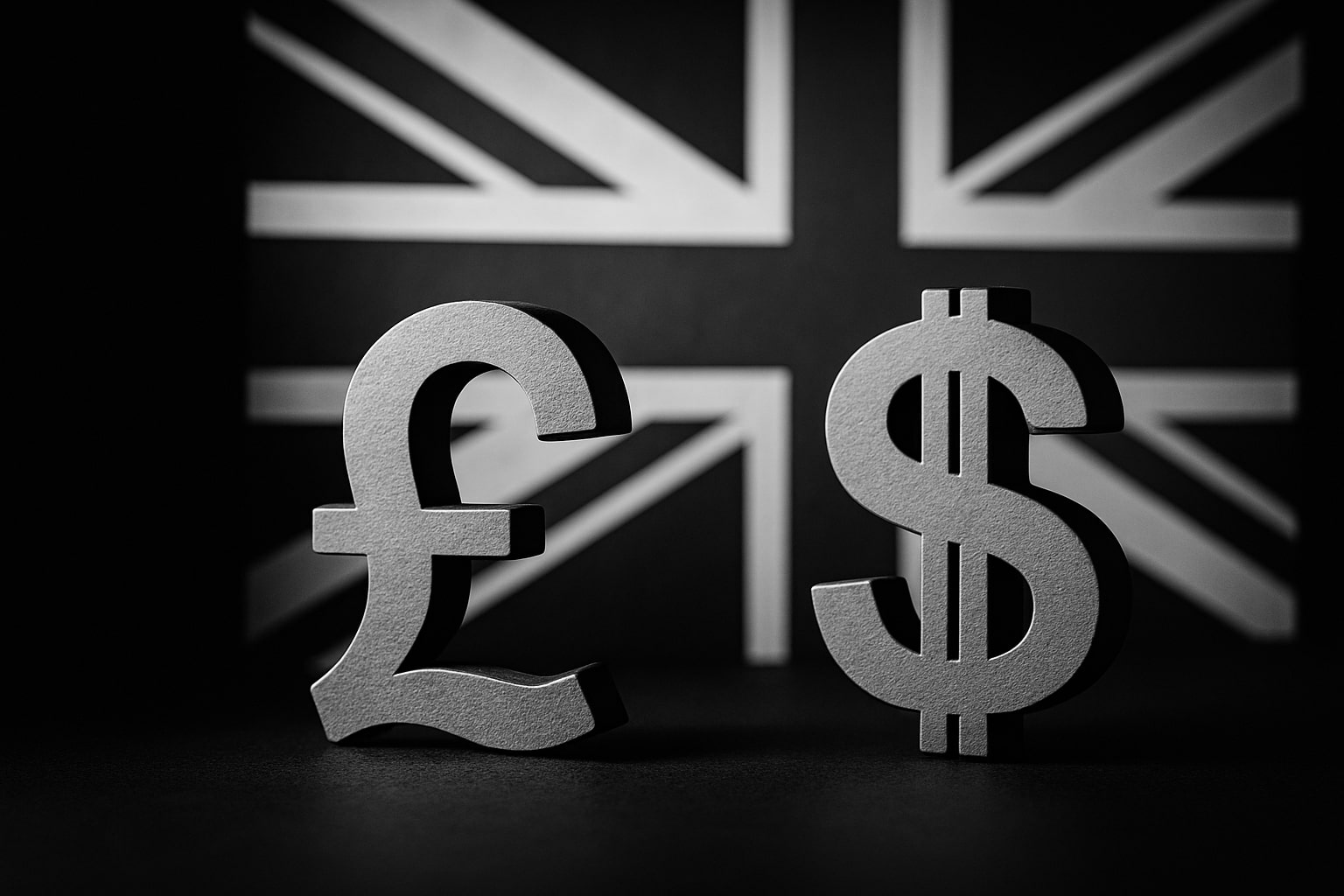
GBP/USD Price Forecast - Pound Sinks to 1.3097, UK Fiscal Gaps Hit Sterling After Market Close
After Friday’s close, GBP/USD extended its slide to a seven-month low, pressured by the Fed’s tough stance on inflation, soaring U.S. yields | That's TradingNEWS
GBP/USD Weekly Analysis: Pound Hits 1.3097 as Fiscal Strain and Fed Hawkishness Trigger Seven-Month Low
The British Pound ended Friday, November 1, sharply lower against the U.S. Dollar, closing near 1.3097, its weakest level since April. The decline capped a third consecutive weekly loss as investors favored the Greenback amid hawkish Federal Reserve remarks and deepening concerns over the United Kingdom’s fiscal outlook. The pair traded within a 1.3090–1.3240 range, failing to hold above the 1.3200 handle as the U.S. Dollar Index (DXY) hovered near 99.80, its highest in three months. The backdrop reflected an uneasy combination of strong U.S. monetary policy, fragile UK fiscal positioning, and mounting skepticism ahead of the country’s November budget.
Fed’s Hawkish Stance Strengthens the Dollar and Caps Sterling Recovery
The Federal Reserve’s latest meeting reignited dollar strength after Chair Jerome Powell reiterated that further rate cuts are “not guaranteed,” despite the October reduction to the 3.75–4.00% range. According to the CME FedWatch Tool, the probability of a December rate cut dropped to 63%, down from over 90% just a week earlier.
Several Fed officials supported this restrictive tone. Cleveland Fed President Beth Hammack stated she would not have supported the October cut, insisting that “monetary conditions must remain tight to ensure inflation’s return to target.” Meanwhile, Atlanta Fed’s Raphael Bostic acknowledged tension between price stability and employment but emphasized that “policy cannot ease prematurely.”
These statements lifted U.S. yields, with the 10-year Treasury yield holding above 4.42%, and drove the DXY toward the key 100.00 resistance. The strong dollar has now gained 2.1% month-to-date, marking its best performance since July. For GBP/USD, this created sustained downside pressure, as investors rotated into safer assets and shorted currencies exposed to fiscal and political risk.
UK Fiscal Constraints and Political Pressure Weigh on Sterling
The Office for Budget Responsibility (OBR) and Institute for Fiscal Studies (IFS) painted a grim outlook for Britain’s finances ahead of the November budget. Productivity is expected to decline by 0.3%, while the budget deficit could widen by £21 billion by 2030 if current spending trends persist. The IFS added that the government already faces a £22 billion shortfall, leaving Chancellor Rachel Reeves minimal room for maneuver without breaking election pledges.
Market sentiment soured as fiscal tightening appeared unavoidable. Traders now expect either tax hikes or increased borrowing, both of which risk slowing growth further. Consumer confidence fell sharply, with GfK’s October reading dropping to its weakest since December 2022, reinforcing fears of soft domestic demand. The UK GDP growth rate, last reported at 0.2% for Q3, shows little sign of acceleration, making it difficult for the Bank of England (BoE) to maintain parity with the Fed’s restrictive stance.
Market Reaction: Sterling Breaks Key Support and Eyes 1.2950 Zone
The pound’s failure to hold 1.3200 triggered algorithmic selling and a cascade of stops around 1.3145–1.3160, a level previously defended for two weeks. The sharp move lower to 1.3097 confirms a decisive breakdown, opening the path toward the 1.2950–1.2980 support area, a zone not tested since March.
Technical indicators remain bearish. The RSI (14) sits at 37, reflecting persistent downward momentum, while the MACD continues to widen below its signal line. The 50-day EMA, currently at 1.3270, has crossed below the 200-day EMA, signaling a bearish continuation pattern known as a death cross. If sustained, the next target aligns with 1.2880, the 0.618 Fibonacci retracement of the March–July recovery.
Conversely, a short-term rebound toward 1.3160–1.3200 remains possible if U.S. yields retreat or if the BoE signals renewed tightening in November. However, for now, the path of least resistance remains to the downside.
Macro Divergence Deepens: BoE Under Pressure as Fed Holds Firm
While the Federal Reserve insists on a prolonged restrictive stance, the Bank of England faces growing calls to ease policy amid slowing domestic growth. The UK’s inflation rate, last recorded at 2.3%, has moderated faster than expected, allowing policymakers limited breathing room. Yet, BoE Governor Andrew Bailey remains cautious, warning that “premature easing risks reigniting price instability.”
The divergence between the Fed’s hawkish tone and the BoE’s cautious neutrality amplifies GBP/USD downside pressure. With the U.S. economy expanding 2.8% year-over-year, while the UK stagnates near zero growth, global investors continue to favor U.S. dollar assets for yield and stability.
This macro imbalance has turned GBP/USD into one of the most sensitive currency pairs to U.S. rate expectations. Even a modest shift in Fed pricing now triggers large Sterling moves, as seen in the 60-pip decline following Powell’s remarks last Thursday.
Derivative Strategies and Institutional Positioning
Options traders have shifted decisively bearish. The 25-delta risk reversal for one-month GBP/USD options stands at –1.45%, the most negative since February, signaling strong demand for downside protection. Institutional flow data show heavy put buying around 1.3050–1.2950 strikes, consistent with expectations of continued weakness.
Derivatives analysts suggest bear put spreads as a cost-effective hedge, buying 1.3050 puts and selling 1.2900s to manage premiums. Meanwhile, the CME Sterling volatility index has risen 5% month-to-month, reflecting elevated uncertainty ahead of the UK budget announcement.
Asset managers are underweight the pound, with CFTC data showing net short positions at 38,200 contracts, the highest since January. Hedge funds, however, remain more tactical, holding light short exposure in anticipation of potential fiscal surprises in November.
Read More
-
SMH ETF: NASDAQ:SMH Hovering at $350 With AI, NVDA and CHIPS Act Fueling the Next Move
16.12.2025 · TradingNEWS ArchiveStocks
-
XRP ETFs XRPI and XRPR: Can $1B Inflows Lift XRP-USD From $1.93 Back Toward $3.66?
16.12.2025 · TradingNEWS ArchiveCrypto
-
Natural Gas Price Forecast: NG=F Falls to $3.80–$3.94 as Warm Winter Kills $5.50 Spike
16.12.2025 · TradingNEWS ArchiveCommodities
-
USD/JPY Price Forecast - USDJPY=X Slides, BoJ 0.50% Hike, Fed Cut and NFP Set the Next Big Move
16.12.2025 · TradingNEWS ArchiveForex
Short-Term Outlook: All Eyes on November Budget
The near-term fate of GBP/USD will hinge on fiscal clarity from Chancellor Reeves. If the November budget introduces credible deficit reduction without aggressive taxation, Sterling could find a temporary floor near 1.30. Conversely, expanded borrowing or delayed fiscal targets could deepen the selloff toward 1.2850.
The U.S. employment data due next week also looms large. A stronger-than-expected Nonfarm Payrolls report could reignite U.S. dollar strength, while weak data might provide a modest reprieve for Sterling. However, the structural divergence between the two economies — higher productivity, stronger growth, and more fiscal flexibility in the U.S. — suggests that any pound recovery would likely be corrective, not trend-defining.
Verdict: Sell — Fiscal Stress and Rate Divergence Cement GBP/USD Downtrend
Given current conditions, GBP/USD remains a Sell. The pair’s break below 1.3100 confirms a technical downtrend reinforced by macro divergence and fiscal deterioration. The combination of a hawkish Fed, sluggish UK growth, and deepening fiscal risks points toward continued downside in November.
While short-term rebounds toward 1.3200–1.3250 may occur, sustained strength appears unlikely without a decisive fiscal surprise from London or a sudden dovish pivot by the Fed. The base case projects GBP/USD testing 1.2950 in the coming weeks, with potential overshoot to 1.2850 if the U.S. dollar maintains momentum.



















